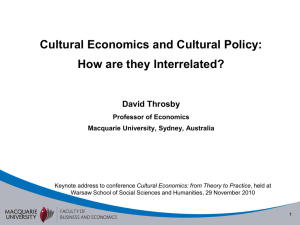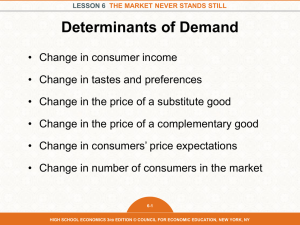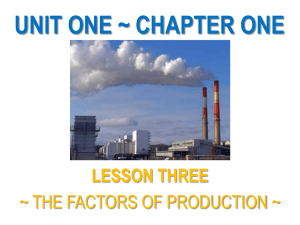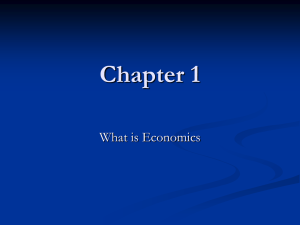of economic science
advertisement
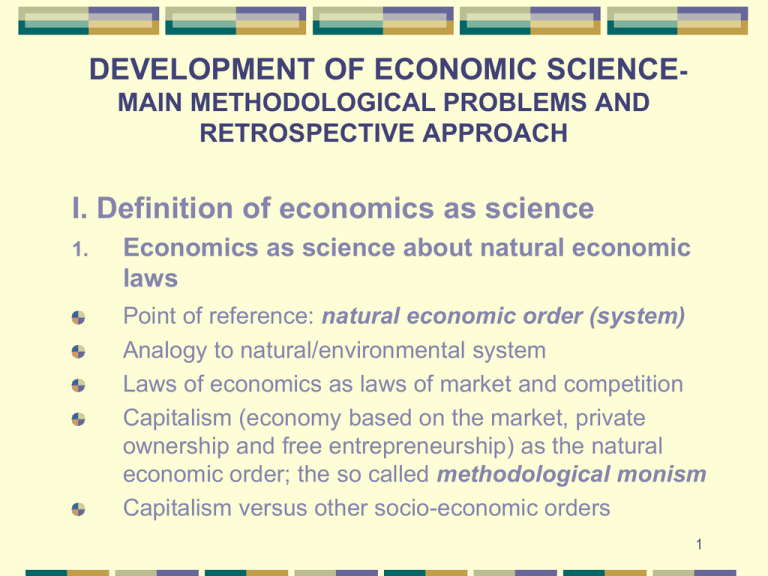
DEVELOPMENT OF ECONOMIC SCIENCEMAIN METHODOLOGICAL PROBLEMS AND RETROSPECTIVE APPROACH I. Definition of economics as science 1. Economics as science about natural economic laws Point of reference: natural economic order (system) Analogy to natural/environmental system Laws of economics as laws of market and competition Capitalism (economy based on the market, private ownership and free entrepreneurship) as the natural economic order; the so called methodological monism Capitalism versus other socio-economic orders 1 I. Definition of economics as science – cont. 2. Historical and institutional approach to economics as science Economics as sociology of economic life (phenomena and processes) and changing over time socio-economic orders (Marxian/Marxist economics, historical school in economics) Economics as the theory of evolution of economic system (instytucjonalism) Common developmant factor: key role played by the science (in anglosaxon meaning of this word) and technology in the economic development (technological determinism) 2 I. Definition of economics as science – cont. 3. Robbins’ definition based on the category of scarcity Point of reference: physical scarcity of resources and goods versus unlimited (endless) character of human needs Features of resources (production factors) : Physical scarcity, Diversified productivity, Possibilities of alternative use 3 I. Definition of economics as science – cont. 3. Robbins’ definition based on the category of scarcity – cont. Features of needs: Unlimited character, Orderliness (consistency of preferences), Importance changing over time Economics as an abstractive (pure) logic of choice, as science on alternative manners of using scarce resources for producing goods which satisfy unlimited (endless) needs Economics deals exclusively with relations between goals (needs) and means serving to achieve those goals 4 I. Definition of economics as science – cont. 4. Economics as a domain of applied mathematics L.M.E. Walras’ approach Economics as the theory of general economic qulibrium Definition of T. Koopmans (activity analysis) Economics as science dealing with optimal distribution (allocation) of scarce resources which are at the disposal of enterprises Definition of P.A. Samuelson Economics as science on conditions of equlibrium (in different scale) and of stability of economic systems 5 I. Definition of economics as science – cont. 5. Attempts at widening the research domain of economis as science (the so called economic imperialism) Economic imperialism: appriopriating by the science of economics of domains (research areas)which are specific for other social sciences; e.g. new institutional economics Economic imperialism vs. cooperation with other social and natural sciences (behavioral economics and finance,, evolutionary economics, psychological economics and others) 6 II. Neo-classical concept of economic science – main components of methodological paradigm of ENC 1. Methodological individualism Behavioral dimension (concept of homo economicus , utility maximization hypothesis; UMH) Cognitive dimension (necessity to identify, to seek for the „microeconomic foundation” of all economic phenomena and processes); relation: microeconomics - macroeconomics) Ideological dimension (economic freedom) 7 II. Neo-classical concept of economics – cont. 1. Methodoligical individualism – cont. • General neoclassical model of microeconomic behavior: optimization of human beings’ activitties Static and dynamic optimization – economic statics and economic dynamics Modifications of homo oeconomicus concept in contemporary economics • • H.Oe. as heuristic (cognitive) concept having the stochastic character H. Simon- concept of bounded rationality (satisftycing instead of maximization or optimization behavior) H. Leibenstein – a selectively rational men; REMM- resourceful and evaluating homo oeconomicus 8 II. Neo-classical concept of economics – cont. 2. Equlibrium concept in w NCE Equlibrium as heuristic (cognitive) fiction and a real feature of economic phenomena and proceses Economic statics and dymamics vs. static and dynamic equilibrium Microeconomic and macroeconomic equilibrium (macroeconomic stabilization) 9 II. NCE concept of economics – cont. 2. Concept of equiulibrium in NCE– cont. Market equilibrium: partial and general (on final goods markets, intermediate goods and production factors markets, financial markets) General equilibrium: static and dynamic (equlibrium growth) Equlibrium vs. disequlibrium (controverses between NCE and Keynesian economics) Equlibrium as a stochastic category 10 II. Neoklasyczna koncepcja ekonomii c.d. 3. Critical rationalism (C. Popper) Genesis: – philosphy of positivism as a commonly accepted general science methodology Essence of the so called falsyphicationism as criterion for appraisal of „scientific character” of generalizations (hipothesis, models, theories etc.) of economic science 11 III. Criteria of progress/development of economic science 1. Criterion of capability to explain the nature of economic phenomena and processes (criterion of the so called scientific realism) 2. Social utilitarity criterion 3. Criterion of predictivity power (Friedman) 4. Mongin’s – Laudan’s criterion of effectiveness (the so called instrumental realism): criterion of higher (increasing with respect to „competitive theories” ) effectiveness in solving scientific problems 12 IV. Main criteria of distinguishing streams (schools) in economics 1. Interpretation of economic categories and laws 2. Market and state as mechanisms of economic coordination and optimization (in macroeconomic scale) 3. Manner of interpretation of value/price of goods, of sources (origins) of social welfare and economic growth factors 13 IV. Main criteria of distinguishing streams (schools) in economics 1. Interpretation of economic categories and laws a) Natural vs. historical b) Deterministic vs. stochastic c) Causal vs. functional d) Economics as a science dealing with economic models and theories and not searching for objective economic laws or principles e) Economics as a science constructing subsequent research paradigms and programs 14 Market and state as regulation mechanisms: paradigm of market vs. paradigm of state The nature of paradigm of market 1. Economic entities take decisions based on the observation of changing market prices 2. Markets are characterized by the feature of alocative effectiveness 3. There occurs a constant tendency to market equilibrium 4. Providing that the equlibrium is effective, there takes place the maximization of social 15 welfare (Pareto optimum) Market and state – cont. Paradigm of market– perfectly competitive (ideal) market as the point of reference Real economic life: occurence of numerous market failures The very nature of market failures: impairing (distortion) of conditions of (1) perfect competition and (2) system of private property rights Most important and common types of market failures: monopolies /oligopolies, external effects, public goods, imperfect information (knowledge), uncertainty and risk 16 Market and state … – cont. Market failures – the need of public regulation Public regulation does not contradict the paradigm of market Normative and economic interpretation of public regulation Diversification of market failures results in the necessity of diversifying methods and instruments of public regulation 17 Market and state … - cont. Point of departure for the paradigm of state: permanent incapability of market mechanism to maximize the social welfare due to (among others) : 1. Lacking tendency towards the macroeconomic equlibrium (Keynesianism) 2. Need for direct defining and implementing by the state od important social objectives (institutionalism, historical school, mercantilism) 3. Tendency towards „anarchy of production” and waste of economic resources (marxist economics) 4. State regulation as quasi-market 18




